Text
Reflection: “How do I develop a Passion for Teaching Dance in my Primary Classroom?”


In the process of developing a passion for Teaching dance in my Primary classroom, I started my journey with learning about the foundations of dance which is based on the three components:
Learning in Dance -It consists of ideas, content, learning, elements, skills, and processes that can help you in developing your understanding/teaching confidence in creative arts. Dance and to follow that the body is an instrument of expression to communicate and express meaning. It includes teaching activities, strategies, and warmups. Learning in Dance involves students exploring elements, skills, and processes through the integrated practices of choreography, performance, and appreciation.
Making in Dance- Making in Dance involves students improvising, choreographing, comparing and contrasting, refining, interpreting, practicing, rehearsing, and performing.
Responding in Dance- Responding in Dance is about students appreciating their own and others’ Dance works by viewing, describing, reflecting on, analysing, appreciating, and evaluating.
Then I learned the values students get from participating in dance, which combines the types of dance and their levels and pathways. The styles of dance, if it is locomotor or non-locomotor. The benefits of dance in the curriculum for the students. Then the elements of dance are Body, Action, Space, Time, Energy. To reach an outcome and accomplish a task in dance, we should cover all these elements. I now understand how and where dance fits in the curriculum and how it can be used as individual learning and integrated into different subjects of KLA’s (Key Learning Areas).
Dance can be planned and programmed depending on the needs of the learners in the classroom. We can keep in mind how we can support them through implementing ideas based on their diversity. This makes it an inclusive and safe environment for all. As we plan to dance, we value the diverse backgrounds and their dance knowledge. We incorporate world views in dance. We represent dance as praise for God or gratitude to Him in showering us an utmost blessing in this world. In the primary classroom, we can embed dancing in all the learning material and areas of study. Dance brings the world closer with connections formed by bringing joy in the lives of precious people in the classroom.
I look forward to my journey in the primary classroom with my understanding of dance and incorporate dance in various ways in my classroom to support my students and provide them safe, happy environment to learn and grow.
Image references
https://www.google.com/url?sa=i&url=https%3A%2F%2Frcfred001.wixsite.com%2Fportfolio%2Fweek-2-music-reflection&psig=AOvVaw1zBG36wCxAGRGTZLj_fTIA&ust=1636111996752000&source=images&cd=vfe&ved=2ahUKEwil4aakzv7zAhV5hGMGHeAIDcYQr4kDegUIARCEAg
https://www.google.com/url?sa=i&url=https%3A%2F%2Fmcsdurham.org%2Fblog%2Fthe-importance-of-dance-in-education&psig=AOvVaw1zBG36wCxAGRGTZLj_fTIA&ust=1636111996752000&source=images&cd=vfe&ved=2ahUKEwil4aakzv7zAhV5hGMGHeAIDcYQr4kDegUIARCSAQ
https://www.google.com/url?sa=i&url=https%3A%2F%2Fthol7511thirdyear.wordpress.com%2Ftag%2Felements-of-dance%2F&psig=AOvVaw1zBG36wCxAGRGTZLj_fTIA&ust=1636111996752000&source=images&cd=vfe&ved=2ahUKEwil4aakzv7zAhV5hGMGHeAIDcYQr4kDegUIARCuAQ
0 notes
Text
Week 13:- How do I assess dance in my primary classroom?


Dance should be assessed in a way that all the elements and outcomes are covered. It should be assessed in a relevant and meaningful way in Primary classroom arts.
Learning in dance
The assessment in dance could be done based on the Australian curriculum outcomes. Assessment as learning could be done through peer assessments and self-reflection as they are the core elements of effective and authentic ways of assessing dance in primary classrooms. Teachers can assess their growth and expertise in the field. Assessment for learning is based on the concept that ability is not fixed, and every child can progress.
Critical components of an effective assessment are:
· Sharing learning goals with students
· Help students to understand the aim
· Involving students in peers assessing, self-assessment as they the responsibility of their learning
· Providing effective feedback on what they did well and what are the areas of improvement
· Reviewing and reflecting on achievement by teachers and peers
Some of the schools focus on the learning objectives and learning outcomes in dance assessment. The effective way of feedback is using learning outcomes to assess what learning has occurred. Teachers should frame the outcomes in child-friendly language so that they understand what knowledge needs to be acquired. At the end of the lesson, the learning outcomes should relate to students:
-Know that
-understand how
-be able to
-explore and understand strategies for
The performance, composing, and appreciation forms the base of these learning outcomes. Teachers should help students to know and recognise the standards. Teachers and students can model and share the work with a broader audience in the form of steps and the product, and everyone should understand, compose and appreciate the learning steps.
Peer and self-assessment encourage students to take responsibility for their learning, use clear success criteria, and use effective questioning and suggestions for improvement, modelled by teachers and practised by students. Peer reflection can include evaluating the task, finding rhythm, repetition, and order, giving feedback and suggesting ideas to improve, assessing by making videos, and taking photos. Feedback should be verbal, regular, consistent, and interactive. Assessment can be done based on the rubric as well.

Making in dance
The students should be able to represent the technical skills of control and accuracy in their dance performance. The technical skills are developed with practise in the performance. The students should be able to dance with expressive skills of focus and projection. These skills help the students to express their moods and story. Teachers can use different types of expressive warm-up experiences.
We can apply the Christian worldview in creating our dance performance, like thanking God for his blessings on us. Below you will see a video attached where I am trying to thank God for the beautiful colours; He has blessed us. Without these colours, our world would be black and white and in hues of grey. I have thanked God with the use of some colourful scarves. Although not all the elements are covered in this performance, I have tried to express my gratitude to God.
Responding/ reflecting in dance:
We must respond and reflect on our performances to evaluate and assess our teaching and learning and reach the goal and outcome. We can reflect on our performance to check on various elements based on the rubric, which covers the outcomes of the Australian curriculum. What have we learned, and what outcomes are covered and achieved in the performance?


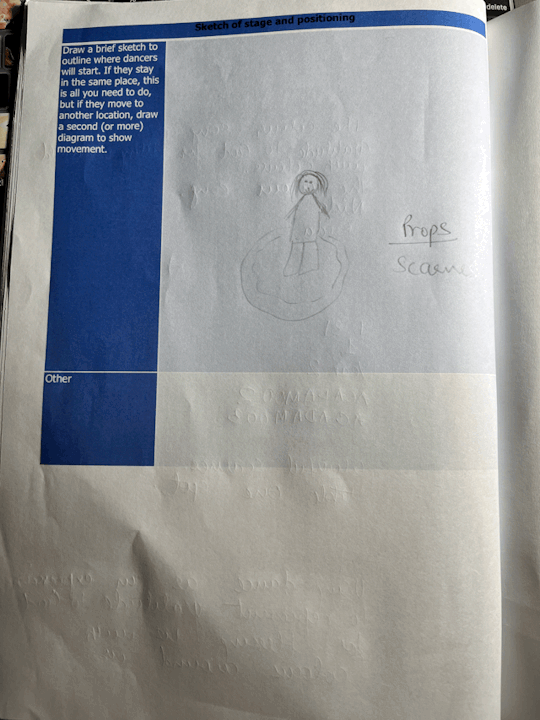

References
Australian Curriculum, Assessment and Reporting Authority [ACARA].(2021) Foundation - Year 10: Arts https://www.australiancurriculum.edu.au/f-10-curriculum/the-arts/dance/?year=12721&capability=ignore&capability=Literacy&capability=Numeracy&capability=Information+and+Communication+Technology+%28ICT%29+Capability&capability=Critical+and+Creative+Thinking&capability=Personal+and+Social+Capability&capability=Ethical+Understanding&capability=Intercultural+Understanding&priority=ignore&priority=Aboriginal+and+Torres+Strait+Islander+Histories+and+Cultures&priority=Asia+and+Australia%E2%80%99s+Engagement+with+Asia&priority=Sustainability&elaborations=true&elaborations=false&scotterms=false&isFirstPageLoad=false
Board of Studies, NSW, April 2006. Creative Arts K-6 Syllabus: Vol.2 https://educationstandards.nsw.edu.au/wps/portal/nesa/k-10/learning-areas/creative-arts/creative-arts-k-6-syllabus
Page, T, (November 1, 2021) Lecture Week 13: How do I plan and assess dance? Moodlebook
https://moodle.avondale.edu.au/mod/book/view.php?id=1234184
image:
https://www.google.com/url?sa=i&url=https%3A%2F%2Fwww.stfxashbury.catholic.edu.au%2Flearning-approach%2Flearning-and-achievement&psig=AOvVaw3MFVdI1EKhD9jSnVUxjeQg&ust=1636107514177000&source=images&cd=vfe&ved=2ahUKEwjWjezKvf7zAhUdxTgGHf4dBhUQr4kDegUIARCGAQ
https://www.google.com/imgres?imgurl=https%3A%2F%2Fwww.kennedy-center.org%2Fglobalassets%2Feducation%2Fresources-for-educators%2Fclassroom-resources%2Fartsedge%2Flesson%2F6-8%2Felements-of-dance%2Felementsofdance.jpg&imgrefurl=https%3A%2F%2Fwww.kennedy-center.org%2Feducation%2Fresources-for-educators%2Fclassroom-resources%2Flessons-and-activities%2Flessons%2F6-8%2Felements-of-dance%2F&tbnid=wkBSRzYRMNOXxM&vet=10CDsQMyiCAWoXChMI2PXh1b3-8wIVAAAAAB0AAAAAEAI..i&docid=95NthtzlUaQWVM&w=1600&h=900&q=assessing%20and%20reporting%20dance&ved=0CDsQMyiCAWoXChMI2PXh1b3-8wIVAAAAAB0AAAAAEAI
0 notes
Text
Week 12: How Do I Plan for and program Dance?

Dance is a medium to express ourselves without words in the form of movements.
Learning in dance:
Dance in creative arts is planned to create body awareness, management, and fitness. It is the scope for expressive development and kinaesthetic performance. Recreational Dance focuses on engaging and challenging students through a kinaesthetic activity that increases their expressive skills and development when included in planning. While planning the experience, the teacher should allow students to build on their previous knowledge, experience, and skill. They should be able to apply their knowledge in different contexts. Programming and planning should be done keeping in mind the diversity of the learners in the class and their individual needs. The planning and programming should be appealable to both boys and girls, modifiable, and achievable to children with different cultures, religious backgrounds. The teachers can plan Dance as a stand-alone subject or integrate it into different KLA’s yearly chapel activities. It could be in the form of 1 term of intensive focus, or weekly or fortnightly focus based on the students' interest and teacher’s way of teaching. It should cover all the outcomes in the curriculum.
The focus of the teachers is to achieve the standards at each stage in the school for Dance.

Making/performing in dance
Dance can be used as brain breaks in the classroom, integrated into various subjects to make the learning easily achievable, which leaves a significant impact on the learner's mind and understanding the elements of dance and covering the different content descriptors in the curriculum. According to the curriculum, all the outcomes in the curriculum are achievable for children from all walks of life. Nothing stops them from developing a dancing skill and understanding the importance of dance in the curriculum and life. All this mainly depends on the integration of dance in the classroom.


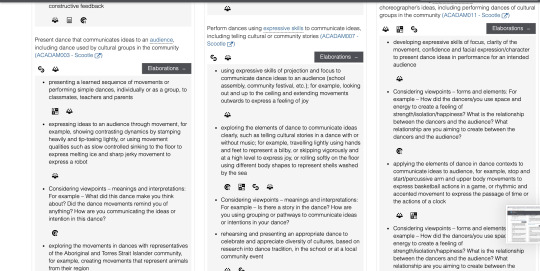

The dance can be integrated into different KLA’s or subjects and cross-curriculum priorities. It can teach students literacy content, numeracy, science, technology, and learning students’ culture of other countries and our own country Australia. Dance can be integrated into maths by explaining various mathematical concepts through dance. They understand the concept of patterns, angles, along with creative work and developing body strength. Percussive dance is used to teach them patterns & direction with precision. Below is the video where me and my daughter were trying to create a percussive dance. This was done with lots of practice and counting to make it while dancing in unison.
Responding/reflecting in dance:

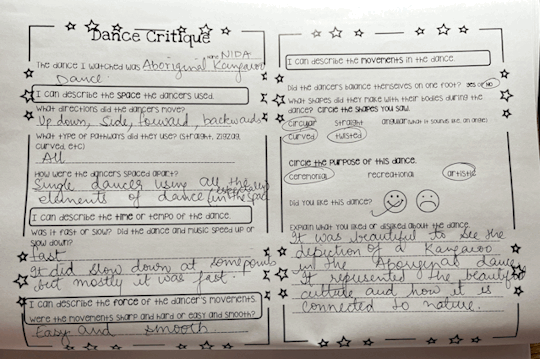
In dance, students should be able to reflect on their learning and making and other students learning and performing a dance as students will be shown some videos and then will be asked to reflect their understanding about the dance creation. They can find the connection of the curriculum, outcomes to general capabilities, and cross-curriculum priorities. The Aboriginal kangaroo dance where students can reflect on the performance in the video and then discuss what the video depicts through the different elements of dance.
References:
Australian Curriculum, Assessment and Reporting Authority [ACARA].(2021) Foundation - Year 10 : Arts https://www.australiancurriculum.edu.au/f-10-curriculum/the-arts/dance/?year=12721&capability=ignore&capability=Literacy&capability=Numeracy&capability=Information+and+Communication+Technology+%28ICT%29+Capability&capability=Critical+and+Creative+Thinking&capability=Personal+and+Social+Capability&capability=Ethical+Understanding&capability=Intercultural+Understanding&priority=ignore&priority=Aboriginal+and+Torres+Strait+Islander+Histories+and+Cultures&priority=Asia+and+Australia%E2%80%99s+Engagement+with+Asia&priority=Sustainability&elaborations=true&elaborations=false&scotterms=false&isFirstPageLoad=false
Board of Studies, NSW, April 2006. Creative Arts K-6 Syllabus: Vol.2 https://educationstandards.nsw.edu.au/wps/portal/nesa/k-10/learning-areas/creative-arts/creative-arts-k-6-syllabus
Page, T, (October 25, 2021) Lecture Week 12 : How do I plan and program dance? Moodlebook https://moodle.avondale.edu.au/mod/book/view.php?id=1234148&chapterid=49705
https://www.google.com/imgres?imgurl=https%3A%2F%2Fichef.bbci.co.uk%2Fimages%2Fic%2F1280xn%2Fp08z2szx.jpg&imgrefurl=https%3A%2F%2Fwww.bbc.co.uk%2Fteach%2Fschool-radio%2Fdance-ks1-ks2-step-by-step-dance-7-11-the-blitz-slideshow%2Fzxr2wnb&tbnid=kraXRI5A45tpKM&vet=12ahUKEwiop9iIgffzAhURnEsFHUW_C14QMygVegUIARCzAQ..i&docid=XLC8x5J5z-q85M&w=1280&h=720&q=planning%20and%20assessing%20dance&client=safari&ved=2ahUKEwiop9iIgffzAhURnEsFHUW_C14QMygVegUIARCzAQ
0 notes
Text
Week 11: How can DANCE be connected through the curriculum?
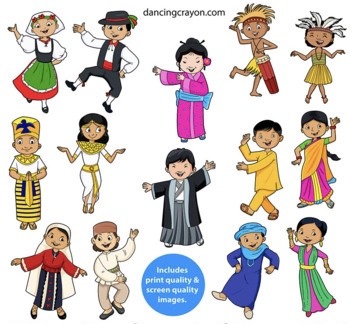
Dance is the medium of expression based on the movements of the body. It helps the people to communicate their feelings with these movements. Dance is an essential element of the creative arts curriculum and has a strong connection with other curriculum areas. It is proven that dance supports the learning process. When a dance is integrated with other Key learning areas, it makes the learning exciting and meaningful. It is observed that dance is connected to general capabilities and cross-curriculum priorities. The general capabilities are numeracy, literacy, ICT, critical and creative thinking, personal and social capability, Ethical understanding, and intercultural understanding. The cross-curriculum priorities are the Aboriginal and Torres Strait Islanders Histories and Cultures, Asia and Australia’s connection with Asia, and sustainability.
Learning in dance
If we understand the connection between dance and the cross-curriculum priorities and general capabilities, then we can better understand the value of dance in the curriculum under the creative arts. Dance can connect to literacy as dance can communicate the message behind poetry, prose in literature. The teachers can use it to represent various concepts of prose and poetry and enhance their literary skills. In early childhood, different rhymes can be incorporated with dance movements. Teachers can explain and use the dance movements to children by counting the rhythm and beats to connect to the numeracy or remembering the times tables. The information and communication technology can be used to digitally record the performances and make necessary changes in the performances. It can be shared on the multimedia platform as it is represented to the audience in the best possible ways. Ethical and intercultural understanding can be developed by understanding the culture, dance, and costumes used in the dance/performances and tradition. The cross-curriculum priorities are the connection to the Aboriginal and Torres Strait Islander histories and cultures, Asia and Australia’s connection with Asia, and sustainability. Teachers can incorporate the histories and cultures, the connections in dance movements in a sustainable way. There is no resource required for dance other than the body.
Making in dance
As dance can be incorporated and connected to different KLA’s, we will see how it connects with the geography curriculum.
(Outcome GE3-1 describes the diverse features and characteristics of places and environments.) Students can explore the cultural diversity of different geographic regions represented through dance. Dance can show the culture through various moves, songs, costumes, and its message through dance. We will see how Indian classical dance is different from other dances around the world. Different types of hand and leg movements are used in Indian classical dance. We will explore the hand and feet movement difference in two dances through two of the performances. Teachers can show the students various dance forms worldwide and question them to identify the differences and types of dances used worldwide in different cultures.
Responding/reflecting in dance.
Students should respond and reflect on the dance-making based on the movements, costumes, music, and message. The dance performances help us connect to the different cultures and traditions. In the video above, the performance is based on the Indian classical movement and dance form. It relates to the geography of the nation and how dance is represented in the culture. Dance can be incorporated in cross curriculum priorities and General capabilities which represents different cultures based on their geography and it represents individual groups and their cultures.



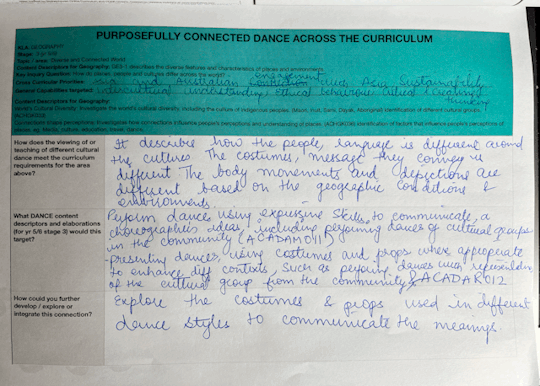
References:
Australian Curriculum, Assessment and Reporting Authority [ACARA].(2021) Foundation - Year 10 : Arts https://www.australiancurriculum.edu.au/f-10-curriculum/the-arts/dance/?year=12721&capability=ignore&capability=Literacy&capability=Numeracy&capability=Information+and+Communication+Technology+%28ICT%29+Capability&capability=Critical+and+Creative+Thinking&capability=Personal+and+Social+Capability&capability=Ethical+Understanding&capability=Intercultural+Understanding&priority=ignore&priority=Aboriginal+and+Torres+Strait+Islander+Histories+and+Cultures&priority=Asia+and+Australia%E2%80%99s+Engagement+with+Asia&priority=Sustainability&elaborations=true&elaborations=false&scotterms=false&isFirstPageLoad=false
Board of Studies, NSW, April 2006. Creative Arts K-6 Syllabus: Vol.2 https://educationstandards.nsw.edu.au/wps/portal/nesa/k-10/learning-areas/creative-arts/creative-arts-k-6-syllabus
Page, T, (October 25, 2021) Lecture Week 11 : How can dance be connected through curriculum, Moodlebook https://moodle.avondale.edu.au/mod/book/view.php?id=1234112&chapterid=49704
https://www.google.com/url?sa=i&url=https%3A%2F%2Fwww.teacherspayteachers.com%2FProduct%2FDancing-Children-of-the-World-Clip-Art-74-Kids-Dance-Party-5825613&psig=AOvVaw04VG62lqqi9bRhD-6-vJe_&ust=1635250953646000&source=images&cd=vfe&ved=0CAwQjhxqFwoTCNDejdfG5fMCFQAAAAAdAAAAABAD
0 notes
Text
Week 10:What are the key dimensions of dance, and where does it fit in the curriculum?


Dance is the medium through which anyone can articulate ideas and express themselves as they convey the message through these movements. Dance has six main elements which are involved in the process of dancing. We might not realise these elements while dancing initially, but as we dig deep, we will find they are always there. It is involved in the primary school curriculum as a creative arts subject for all age groups and stages.
Learning in Dance:
Dance is involved in the curriculum for the children to engage in the experience, develop trust and confidence, develop cohesion and focus on the purpose of dancing. So, the teachers establish effective dance plans to teach and assess them. The children learn to use their body as the instrument and movement as the medium of dance. The children use dance to explore, organise, and refine movements for choreography and performance. With an effective program, the children develop their movement vocabulary and use their knowledge to develop their technical skills and aesthetic understanding.
The role of the teacher in this learning process is to have a clear purpose of the experience, planning effective dance experiences which support in engaging students in a safe way to build confidence, trust, build cohesion and focus in the learning experience. Teachers can use different props as stimuli for the children to express ideas and expression through dance. The teachers can use dance to teach cross-curriculum subjects like science, maths, history, culture, and spirituality. Warmups are used for the children to get in the mood and get their bodies ready for developing and exploring technical skills.

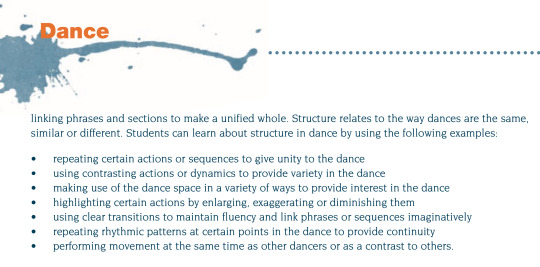
Making/performing in dance:
The children will perform starting from the fundamental movement skills and warm-up, which will support their ideas of the elements of dance: body, space, time, dynamics, and relationships. The children will understand the kinesthetics of the movements and will be able to explore, express, interpret, and communicate their ideas through the process. Below you will see the video in which we are learning about the life cycle of a butterfly through dance and movement. Various elements are involved in the dance to communicate and interpret the idea of the life cycle of a butterfly.

Responding/appreciating in dance:
Responding in dance is about students appreciating their own and others’ dance by viewing, describing, reflecting on, appreciating, and evaluating the dance performance. The students watch the children's performances and reflect on their performance as they use different elements and convey their message. They see how they have communicated and interpreted their message through their performance and other children’s performance. Students will learn to appreciate their peers and evaluate the dance with their teachers and peers. The teachers will evaluate the dance activity and assess children based on their performances.
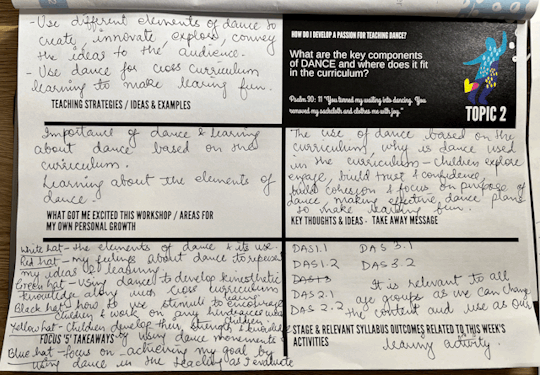
References:
Board of Studies, NSW, April 2006. Creative Arts K-6 Syllabus: Vol.2 https://educationstandards.nsw.edu.au/wps/portal/nesa/k-10/learning-areas/creative-arts/creative-arts-k-6-syllabus
Page, T, October 11, 2021. Week 10: What are the key dimensions of dance and where does it fit in the curriculum? Lecture- Moodle book https://moodle.avondale.edu.au/mod/book/view.php?id=1234067&chapterid=45551
Images:
https://sites.google.com/a/oratia.school.nz/room-22/other-curriculum-areas/the-arts/dance/term2week9-elementsofdance
https://www.google.com/url?sa=i&url=https%3A%2F%2Fwww.dancecurriculum.com.au%2F&psig=AOvVaw1uGwBffiDYt4NOW8cgyLjk&ust=1634529228102000&source=images&cd=vfe&ved=2ahUKEwip9rKBxtDzAhVfnksFHSh0APMQr4kDegUIARCwAQ
0 notes
Text
Week 9: WHAT VALUE DO STUDENTS GET FROM PARTICIPATING IN DANCE?

We should understand and value dance as an essential tool to express ourselves, our emotions as we teach, learn, celebrate, and praise the Lord. It is the gift to express and communicate, which we can cherish always. The value and benefit of dance can be life changing.
Learning in Dance


The NSW curriculum in the pictures above displays the content descriptions of Creative Arts -Dance based on the foundation of Dance in the primary school setting. We should know the elements of Dance to understand dance and then teach dance to the children.

Teachers should know the elements, skills, and processes involved in dance to teach the students all of the above through integrated choreography, performance, and appreciation practices. The students should understand the difference between dance in creative arts and PDHPE. The dance moves in creative arts dance are based on the flexibility of the body.
Steps involved in learning in dance are:
Step 1: Get the body ready with warming up- Warming up of the body should be depending on the age and personality of the students. For younger students, it should be game-based, and with older children, it should describe things with proper vocabulary and teaching them to respect and value their bodies.
Step 2: Teach students the difference between locomotor and non-locomotor dance moves. The locomotor dance uses the entire body and has different levels and pathways.

Non-locomotor dance uses the available space around the axis of the body. The body remains stationary. It helps the students to develop confidence and explore how the bodies can express themselves.
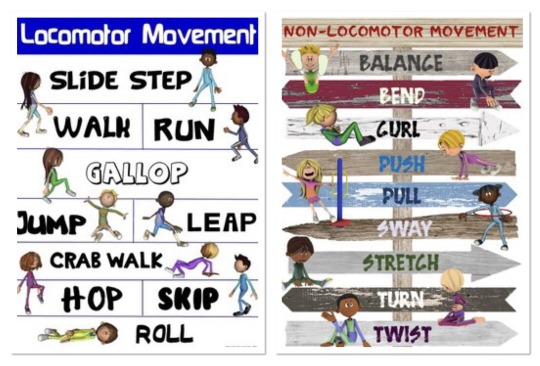
The teachers can use these movements to teach dance to the students or as brain breaks, fun exercises, and lessons in the class.
Making in Dance
Making in dance involves students improvising, choreographing, comparing, contrasting, refining, interpreting, practicing, rehearsing, and performing.

The teachers can use dance to help children learn the letters of their names, can challenge them with coded movements for different letters of their names. The making of the letters of their name is suitable for year two students, the coded movement dance, and Using stimulus (images, issues, concepts, music, etc.) as a tool for creating dance and movement.
Responding/ Appreciating in Dance

Responding in dance is about students appreciating their own and others' dance works by viewing, describing, reflecting on, analysing, appreciating, and evaluating. The students can reflect on their learning and appreciate their friend's performance by analysing the performance respectably.

References
Board of Studies, NSW, April 2006. Creative Arts K-6 Syllabus: Vol.2 https://educationstandards.nsw.edu.au/wps/portal/nesa/k-10/learning-areas/creative-arts/creative-arts-k-6-syllabus
Page, T, September 27, 2021. Week 9: What value do students get from participating in dance? Lecture- Moodle book https://moodle.avondale.edu.au/mod/book/view.php?id=1234022
Images:
https://www.teacherspayteachers.com/Browse/Search:locomotor%20movement%20posters
https://www.google.com/url?sa=i&url=http%3A%2F%2Fwww.clipartbest.com%2Fclass-of-children-clip-art&psig=AOvVaw2ttkSEoiddHst_AmaYn632&ust=1633949111000000&source=images&cd=vfe&ved=2ahUKEwiz9oD01L_zAhXckUsFHTUAC-UQr4kDegUIARCnAg
0 notes
Text
"How do I develop a Passion for Teaching Dance in my Primary Classroom"- Nida Parveen
0 notes
Text
Reflection-How can I teach primary music with passion and confidence?

Music is everywhere around us. Music in the birds chirping, in our walks, clock ticking, in the wind, as it makes the leaves rustle, the moving car, moving bike, etc. It is everywhere, but sometimes we notice and sometimes we don’t. It can be learned by understanding all the elements of Music.
The foundations of Music in a Primary school setting:
Learning in Music - Learning in Music involves exploring the elements of Music and how they work together, various forms of musical notation, and technical skills in singing and playing instruments. It also involves learning how to teach, program, and assess these areas.
Making in Music- Making in Music involves students exploring, improvising, composing, notating, practicing, refining, and performing.
Responding in Music - Responding in Music is about students appreciating their own and others’ musical works by listening, describing, reflecting on, analysing, appreciating, and evaluating.
ACARA has designed the curriculum so that the children have a fair understanding of music at the end of each year in the school. The below achievement standards are considered when assessing children:
“By the end of Year 2, students communicate about the music they listen to, make and perform and where and why people make music.
Students improvise, compose, arrange and perform music. They demonstrate aural skills by staying in tune and keeping in time when they sing and play.”
“By the end of Year 4, students describe and discuss similarities and differences between the music they listen to, compose and perform. They discuss how they and others use the elements of music in performance and composition.
Students collaborate to improvise, compose and arrange sound, silence, tempo, and volume in music that communicates ideas. They demonstrate aural skills by singing and playing instruments with accurate pitch, rhythm, and expression.”
“By the end of Year 6, students explain how the elements of music are used to communicate meaning in the music they listen to, compose and perform. They describe how music is influenced by music and performances from different cultures, times, and places.
Students use rhythm, pitch, and form symbols and terminology to compose and perform music. They sing and play music in different styles, demonstrating aural, technical, and expressive skills by singing and playing instruments with accurate pitch, rhythm, and expression in performances for audiences.” (ACARA Music Curriculum, Achievement Standards)
Learning music can help students develop self-confidence, self-discipline, and teamwork. It builds confidence, self-expression and fosters creativity. An education inclusive of music maximises student opportunity. Music helps students progress in other important learning areas such as Maths and English, which involves learning to recognise and use patterns and sequences when composing, performing, and listening. Music stimulates incomparable development of a child’s brain and leads to improved concentration and memory abilities.
Music help students to acquire knowledge, skills, and understanding in performing music of different genres and other cultures. Children develop their knowledge, skills, and knowledge of their music and others. It also assists students in participating in and contributing to cultural life, becoming informed consumers of the arts and culture, empathizing with others, and considering their career paths.
Students can develop their aural skills and an understanding of pitch by exploring sounds in the environment, like recognizing the sound of a bus when compared with a lorry and at home, such as hearing the difference between banging on a small piece of a cardboard box and a big plastic box. You can buy simple instruments like drums or tambourines or make your shaker from rice grains in a plastic bottle. When they learn about the pitch, it helps them develop their aural skills, essential for understanding music. The dynamics of music helps in learning music, making music, and responding to music.
The music can be planned as a sole subject and by embedding it in different subjects and KLA’s to develop the understanding in students. The experiences can be designed and organised to be done in the class.
It can be assessed as group work or individual performances. But it is believed that it puts more pressure on the children as they perform individually. It is recommended that it be assessed in a small group of 4-5 children so that teachers can assess their learning and do not get stressed during the process.
Music can express emotions which could be done through emotion check with the children via music. They can express themselves and communicate with music. Music has changed over time based on cultures and society. Music has been used to praise God and express emotions like romanticism, fear, hope. Later in the times, it was seen to be full of dissonance and unusual harmonies.
The innovations in technologies made it possible for people to experience music everywhere. Understanding the evolution of music can help the teachers provide in-depth understanding and then make children aware of the simple instruments used in ancient times and the history, importance of music, musical instruments, and how music has evolved with time. The evolution of music with time and being shared in different regions and societies with various mediums has made music endure throughout.
The understanding of the music and the curriculum helps me get the confidence. This confidence ultimately fuels my passion for teaching music in the classroom setting. It makes me aware of every aspect that I should consider in planning, designing, and incorporating it in my teaching as sole subject and embedded in different KLA’s to make learning fun and memorable.
References:
Caldwell, E. (2016, January 12). Teacher Tuesday: teaching high and low pitch | Organized Chaos. Teacher Tuesday. https://caldwellorganizedchaos.blogspot.com/2016/01/teacher-tuesday-teaching-high-and-low.html?m=1
Codrops. (2017, April 19). » Communication Through MusicThe Music Studio. Themusicstudio.ca. https://www.themusicstudio.ca/blog/2017/04/communication-through-music/
Music. (n.d.). Www.australiancurriculum.edu.au. Retrieved October 1, 2021, from https://www.australiancurriculum.edu.au/f-10-curriculum/the-arts/music/?year=12746&year=
Page, T (2021, August 9) Week 1& 2: What are the foundation of teaching creative arts: Music & dance. Moodle book https://moodle.avondale.edu.au/mod/book/view.php?id=1233992
Page, T (August 16,2021) Week 3: What is the place and value of music in theCurriculum? Moodle book https://moodle.avondale.edu.au/mod/book/view.php?id=1234256
Page, T ( 2021, August 23) (Wk4) How can I teach my students about Rhythm moodle book https://moodle.avondale.edu.au/mod/book/view.php?id=1234304
Page, T (2021, August 30 )Week 5:How can I help my students develop aural skills and an understanding of pitch? Moodle book https://moodle.avondale.edu.au/mod/book/view.php?id=1234346
Page, T (2021, September 6) Week 6 How can I plan for and assess music in my classroom? Moodle book https://moodle.avondale.edu.au/course/view.php?id=10844#section-6
Page, T (2021, September 13) Week 7:How does music communicate a message, and what impact will this have on my teaching? (Lecture) https://moodle.avondale.edu.au/mod/book/view.php?id=1234439&chapterid=45629
Page, T, 2021) Week8lecture: Music Through Time and Space, Moodle book https://moodle.avondale.edu.au/mod/book/view.php?id=1234463 https://www.google.com/url?
Why music is one of the best ways to teach children how to communicate! - WizeTherapy. (2018, May 16). Wize Therapy. http://www.wizetherapy.com.au/why-music-is-one-of-the-best-ways-to-teach-children-how-to-communicate/
Image:
https://www.google.com/url?sa=i&url=https%3A%2F%2Fwww.ludwig-van.com%2Ftoronto%2F2013%2F10%2F12%2Fthanksgiving-weekend-reflection-music-as-a-window-on-what-makes-people-who-they-are%2F&psig=AOvVaw2Xu3Tn40nL62H8oZHcwQnY&ust=1633153030118000&source=images&cd=vfe&ved=2ahUKEwie94ejv6jzAhUmoksFHX9mCGkQr4kDegUIARCSAg
0 notes
Text
Week 8: How does Music change over time, and what makes Music endure?


Music has changed over time based on cultures and society. As the people and society have changed, so has the music in these times. All societies and cultures have used music in different settings and circumstances. The technology has evolved, and so has the music based on the new instruments, which have changed music.
In ancient times, music was used to praise God and get people gathered for services. The instruments used were harps, trumpets which are string instruments, along cymbals. Flutes and drums were used in weddings, funerals to represent joy and sorrow. Music was used as a means of teaching society. After some time, music and musical instruments were meant to be used by the professionals only in the church.
In the Renaissance period, the instruments, music, and societies changed and were modified and used on different occasions. Religious music was used as the base for making the music used in secular regions and gatherings. Music was crossing over from one area to the other and from one society to the other as the societies evolved and the people travelled from one place to other. It was carried and passed on to different regions.
The Baroque period refers to highly ornate and extravagant styles of art, music, and architecture evolved. The music was made with experimentation, innovation with new instruments during this time. Operas came into existence, and the events were organised, which were grand. Different types of music were developed, and composers made their specific compositions. The development of instruments like Piano took place, used in various Gala events in that period. The music was still used in religious events but at a grand level. Some of the compositions are still used in these times around Christmas.
The classical period was the reaction of the grand music of the Baroque period. It became popular in Vienna, Austria. The pianoforte became popular. The music became lighter in texture and became less complex for the audience and composers. These music compositions became popular and were used in dinners and parties for wealthy people regularly.
The Romantic period emphasised emotions and feelings through music. Music depicted fear, love, and hope. The large compositions were made with ensembles. There was dissonance, and unusual harmonies played at this time. Huge orchestras were made, and there was a variety of musical instruments used in these orchestras.
The music in the twentieth and twenty-first centuries has become very diverse because of the different instruments and the composers who wanted to develop variety and something unique. The new technologies allowed listening to eclectic music as recorded and passed on from one region to the other. The instruments were getting electronic, the events and shows were organised, and people travelled to listen to and participate in different music events. The music was exchanged and experimented with, making the new versions and variety. The latest genres were invented and introduced to society. The invention and development of amplifying instruments made it possible to organise large concerts. Digital and electronic instruments have become popular.
Music has evolved with time, and this has made it possible to endure through these times.
References:
Page, T ( 2021,September 20,) Week8lecture: Music Through Time and Space, Moodlebook https://moodle.avondale.edu.au/mod/book/view.php?id=1234463
https://www.google.com/url?sa=i&url=https%3A%2F%2Fwww.vectorstock.com%2Froyalty-free-vector%2Fevolution-of-music-vector-4256901&psig=AOvVaw2CgNHFssqaIY-McUj-PT34&ust=1632835072441000&source=images&cd=vfe&ved=2ahUKEwjatIPlnp_zAhVbjEsFHXVKCBIQr4kDegUIARDUAQ
https://www.google.com/url?sa=i&url=https%3A%2F%2Fliveforlivemusic.com%2Ffeatures%2Fscientific-study-shows-music-evolves-in-the-same-way-as-life%2F&psig=AOvVaw2CgNHFssqaIY-McUj-PT34&ust=1632835072441000&source=images&cd=vfe&ved=2ahUKEwjatIPlnp_zAhVbjEsFHXVKCBIQr4kDegUIARCPAg
0 notes
Text
Week 7: How does music communicate a message and what impact will this have on my teaching?

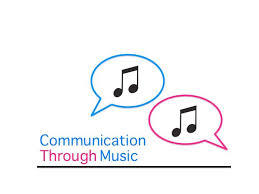
Music has communicated and passed on the message since ancient times. The drums were used to communicate the messages of the arrival of enemies, friends in their area to far-off people. There were particular rhythms or beats as codes for communicating from a distance. Today music expresses and conveys the message through emotions. Tempo, mode, volume, and melody are used to express feelings through music.
Tempo is the pace and speed of the music. Fast rhythms are usually associated with happiness, excitement, and anger, while a slow tempo conveys sadness or serenity.
Mode is the type of scale with a significant mode communicating happiness and joy, while a minor mode corresponds to sadness.
Loudness or volume can convey the intensity and power of emotion, anger.
A melody can communicate emotions. Harmonies can complement to show happiness, relaxation, and serenity, and clashing harmonies convey excitement, anger, or unpleasantness.
Lastly, music’s rhythm can also communicate several emotions. Consistent rhythm associates with happiness and peace, and rough or irregular rhythms speak of amusement or uneasiness. Lastly, music with varied rhythms conveys a feeling of joy.
The listeners can also influence how they perceive music. Listeners use their individual and social identity to interpret what they hear. These include features like their personality, age, knowledge of music, what motivated them to listen in the first place, and their emotions. The aspects of performance, notably its setting, have a significant impact on emotions. A similar song performed at a funeral and wedding will display different meanings and emotions for the listeners. Music breaks down cultural differences and communicates in a way that we can all understand.
Manfred Clynes, a neurophysiologist and researcher, stated, “Music is an organisation created to dictate feelings to the listener. The composer is an unrelenting dictator, and we choose to subject ourselves to him when we listen to the music.” The composer can manipulate the tone of the music to express emotions through certain predicted forms called essentic forms. The accurate composition of this form can communicate a powerful message. Jules Combarieu, a French scholar, explained the relationship of music with society. He pointed out that the ideas in the listener's mind affect the musical experience as he associates the music played. Daniel Levitin explained that the setting and the listener's expectations play a significant role in communicating the message through music. The effect of the music mainly depends on how wilfully we offer ourselves to music in the listening experience, which brings out our imaginations and expectations.
Music is now used our express our emotions, and Rhythm can communicate energy, sadness, happiness, lifting our moods. The dynamics of the music can help us share the message in different ways. Music can help us express the situations and conditions based on the loudness and softness of the music. It is seen in various times that it is used to create suspense, happiness, excitement, sadness, horror through the music notes played. We relate all these emotions with the dynamics.
We, as educators, use the music with the children to express their emotions in the class. We can ask them how they are feeling and show that through any kind of musical instrument in the class. The other way we can use the music is to communicate stories and lessons by creating and playing the music. The children can work collaboratively in groups to tell the stories with the music created with instruments or everyday items around them to tell the story. This could help children regulate their emotions as they can express and improve concentration when they work on the task together. As music is the universal language using this medium, children can better develop their language to express and communicate.
References
Codrops. (2017, April 19). » Communication Through MusicThe Music Studio. Themusicstudio.ca. https://www.themusicstudio.ca/blog/2017/04/communication-through-music/
Page, T (2021, September 13) Week 7:How does music communicate a message, and what impact will this have on my teaching? (Lecture) https://moodle.avondale.edu.au/mod/book/view.php?id=1234439&chapterid=45629
Why music is one of the best ways to teach children how to communicate! - WizeTherapy. (2018, May 16). WizeTherapy. http://www.wizetherapy.com.au/why-music-is-one-of-the-best-ways-to-teach-children-how-to-communicate/
https://www.google.com/url?sa=i&url=https%3A%2F%2Fwww.facebook.com%2Fcommunicationthroughmusic%2Fphotos%2F&psig=AOvVaw39J2zcCkHDI3rUbTeB2n3u&ust=1632225792085000&source=images&cd=vfe&ved=2ahUKEwjF3MGFwY3zAhUesksFHS89BUMQr4kDegQIARBE
https://www.google.com/imgres?imgurl=https%3A%2F%2Fwhatismusic.info%2Fblog%2FLanguageDisplacementAndTheStateOfMindInducedByMusic.images%2Fmusiccommunication.png&imgrefurl=https%3A%2F%2Fwhatismusic.info%2Fblog%2FLanguageDisplacementAndTheStateOfMindInducedByMusic.html&tbnid=DhBvj6D0F4LX6M&vet=12ahUKEwjF3MGFwY3zAhUesksFHS89BUMQMygkegUIARCFAg..i&docid=w0bmO0GVGYF8aM&w=635&h=613&q=music%20and%20communication&client=safari&ved=2ahUKEwjF3MGFwY3zAhUesksFHS89BUMQMygkegUIARCFAg
0 notes
Text
Week 6: How can I plan for and assess music in the classroom?

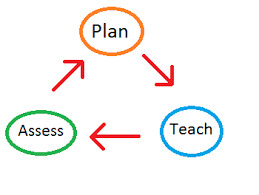
Planning
We all know that music is an essential tool to make learning exciting and fun in all age groups. The music should be planned to teach in the classroom setting based on meeting the outcomes of the curriculum by the Australian Curriculum Assessment, Reporting Authority (ACARA) and the NSW Education Standards Authority.
There are different approaches to planning music in the curriculum.
1-The first is teaching music as the standard sole subject in the classroom with a specialised teacher and scheduling the music lessons in the timetable regularly. E.g., teaching with a music specialist gives the children valuable release time from the other key learning areas of study during the day.
2- The second method is integrating music with other learning areas and subjects. We can select music learning, a music-making process in enhancing the children’s learning of the specific learning areas. Eg. Children can use music in learning history to create a play on the topics of the History curriculum. This will leave a significant impact on their mind, and children will remember the events well.
Music and PDHPE- Children can be encouraged to make a song for making healthy choices or keeping fit.
Music and maths- Making a song to remember times tables,
Music and Science- Make a rhyme for the formulas or the periodic table, learning the continents.
Music and Religion- The values of Christianity can be incorporated in music learning and making as they can musically say the prayers.
3-Inquiry based approach- Music can be planned as a project where the children focus on learning music, making music, and responding and reflecting in music in the form of a project-inquiry. It gives a strong purpose for learning. It could be a project to compose any song based on the other curriculum learning or investigating and learning on a theme to draw on and draw in the knowledge in multiple KLA’s. The children can inquire based on the event, its importance, dancing, costumes, music, performing at the stage, and evaluate the artwork involved based on the curriculum requirement.
Assessing –
The assessment in the music is based on the three broad areas.
1-To assess children’s knowledge of music, understanding of music which is their learning of music.
2-Assess how well the students can use their understanding, knowledge, and skills at the end of the unit to complete any task independently. The summative assessment covers the assessment in making and composing music and then responding and reflecting in music.
3-Assessing how well the learner is developing the habit of learning in character. This is the development of lifelong learners.
Types of assessment-
1-Teacher observation-
1-The teachers observe the children in the learning, making of the music. But before that, for the teacher who assesses the student, she must have a sound knowledge of the music curriculum. So that she knows what to expect of the children and at what level and ability. A teacher should observe the student's abilities, watch them sing, play music in the classroom.
2-Listen as the students talk about the music in the class discussions and with the other children as they create music and perform.
3-By asking informal questions about music-making during the process of learning and making of the music.
4-Watch the children as to how actively they listen to the music.
5-Observe the children how they write and discuss the music in given tasks.
6-Listen and check if they can perform on a rhythmic pattern in the class.
7-Explore their approach of picking on new songs and ease of replicating the same.
8-Observe the proficiency of the children in playing the instruments in the class.
9-Explore how they compose new sounds, melodies, rhythms in a group task.
10-while making a continuous informal judgement of student's work, attitude, skills, and understanding.
Tips for effective assessment
-Put children in small groups of 4-5 children and then ask them to sing and play together. This way, it gets easier to assess all children. The children will feel less pressure to perform in a big group, or if done individually, they feel the pressure of performing independently.
With this strategy, the children gain confidence in creating music and understanding as they feel valued in making the music.
2- Teacher designed tasks and test
It is done as a progress check like any other subject, where the teacher assigns a set task and lets them complete it. It helps write about the child’s performance, e.g., assessing playing a melody or tune given by the teacher and asking children to create their melody tune and explain their creation.
In this area, the assessment is done in the following ways-
Performance assessment- The child creates a piece and then records it performing, and the teacher then assesses it.
Process assessment- The group decides on their vocal sound for an exercise and completes it all together.
Process and performance together- combination works on how the group has worked on their composition and arranged the instruments and music to complete the task.
Tips-
Create a natural flow by making it a normal learning process on a particular topic so that the teacher gets time to assess children at the end of each task continually.
3-Work samples and portfolios-
It is keeping the record of the children's creativity and work and work samples which can be used on assessing three things -learning in music, making in music, and responding and reflecting in music. It contains their invented notations, drafts, composition, listening tests used in report writing, and rubrics they have marked for tasks. It is essential to make the journey visible to work well in the future. It helps to see the aspects of children’s likes and dislikes tracks their development.
4-Project work-
Assess children through project work as they collaboratively work with other children, gets a good insight of how individual children can be assessed in their learning. E.g., Composing music for a story,
Playing music from memory, composing a song, inventing a new form of notation, dance sequences. It is used to compare and contrast the different children and their performances. It could be used for summative assessment of the child, which gives the planned and organised way of assessing based on the defined outcomes. The children can be asked to produce an eight-line poem about nature that will have set perimeters to work on their tasks.
5-Curriculum portfolios- This emphasizes assessing based on the content descriptors in the curriculum. It records the student's achievement based on the formative and summative methods used in report writing, rubric tasks, and making it visible to children to know their journey well and know how they have worked throughout.
Tips-
Always maintain a system in which the teacher is confident. It should be done in the class so that the teacher sees the real-time performances and aptitude of the children. The children's progress should be recorded and visible for the children and be used in their portfolio, which helps in the final assessment of the children. It can be done through audio recordings, visuals, graphic notations. This should be in the way that that the teacher is confident and has convenience.
Reference
Page, T (2021, September 06) Week 6 How can I plan for and assess music in my classroom? Moodlebook https://moodle.avondale.edu.au/course/view.php?id=10844#section-6
Image courtesy
https://www.google.com/url?sa=i&url=https%3A%2F%2Fmypad.northampton.ac.uk%2Fhannahf2%2Ftag%2Fcycle-of-assessment%2F&psig=AOvVaw3SbKdUmW9jM0A9Us9lU0d8&ust=1631621897981000&source=images&cd=vfe&ved=2ahUKEwjl3K6u9_vyAhXETX0KHR4zBmEQr4kDegUIARCRAg
https://www.google.com/url?sa=i&url=https%3A%2F%2Fslideplayer.com%2Fslide%2F6318618%2F&psig=AOvVaw3SbKdUmW9jM0A9Us9lU0d8&ust=1631621897981000&source=images&cd=vfe&ved=2ahUKEwjl3K6u9_vyAhXETX0KHR4zBmEQr4kDegUIARDDAQ
0 notes
Text
Week 5: How can I help my students develop their aural skills and an understanding of pitch?


Developing Aural skills is the kind of musical ear training where the ear identifies the pitches, rhythm, and other key elements of music. Musical training is unique as it emphasizes developing a sensory function (hearing) as a vital component. If you can:
hear and adjust your intonation while playing
hear the quality of a chord
listen and recognize pitches in a melody, or the chords of a progression
tap a rhythm that you have heard
sing a melody at sight from written music without the aid of a piano or other instrument
It means you have already begun to develop an acute sense of hearing. Success as a musician depends by and large on our ability to hear quickly and accurately the music we see and hear. The children learn to analyse their sounds, imitate the rhythm, and understand pitch high or low. Aural awareness is essential to learning music because it helps students develop their musical perception, memory, understanding, and discrimination. Aural skills inform all aspects of musicianship. They help with both reading and memorizing music and promote more stylish, convincing performances.
The children can develop their aural skills by exploring sounds in the environment, like recognizing the sound of a bus when compared with a lorry and at home, such as hearing the difference between banging on a small piece of a cardboard box and a big plastic box. You can buy simple instruments like drums or tambourines or make your shaker from rice grains in a plastic bottle.
The frequency of a sound measures pitch. Pitch is used to describe high or low notes of the sound. Sounds are higher or lower in pitch according to the frequency of vibration of the sound waves produce. Different instruments have different pitches. In everyday life, we see lots of things around from where children can understand the pitch, like the sound of the animals. The bigger animals have a low pitch, and the small animals have a higher pitch. E.g., Cow moos in a low pitch, and the birds chirp on a high note. We can teach them to identify pitch with different musical instruments by playing them and understanding the sound it makes. These can be explained with the hand movements in the beginning till they know what pitches are. We can use the resources around the room and make sounds with them to teach them the pitch of the sound. Children can be taught about the different pitches in the class while we play games with the children. Imitation games with the children as the teacher sing and lets them draw their pitches on the boards and understand how the pitches show the highs and lows with visual representations and actions of the rhythm and beats. We can also teach pitch with stories depicting high and low concepts. Up, middle and down concepts can be taught with videos online, and then let them make their music with different rhythms, notes, and pitches and let them differentiate the other pitches in their music.
References
Caldwell, E. (2016, January 12). Teacher Tuesday: teaching high and low pitch | Organized Chaos. Teacher Tuesday. https://caldwellorganizedchaos.blogspot.com/2016/01/teacher-tuesday-teaching-high-and-low.html?m=1
How to Help Your Child Develop Perfect Pitch. (2010, March 22). Nurture for the Future. https://figur8.net/2010/03/22/how-to-help-your-child-develop-perfect-pitch/
Page, T (2021, August 30 )Week 5:How can I help my students develop aural skills and an understanding of pitch? Moodlebook https://moodle.avondale.edu.au/mod/book/view.php?id=1234346
The Editors of Encyclopedia Britannica. (2018). Pitch | music. In Encyclopædia Britannica. https://www.britannica.com/art/pitch-music
0 notes
Text
Week 4:How can I teach my students Rhythm?
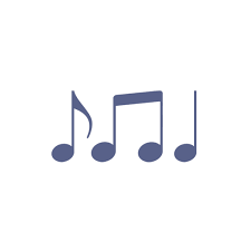

Rhythm is one of the eight elements of music. It is a strong, regular repeated pattern of movement and sound. Precisely in the musical way, Rhythm is the pattern of sound, silence, and emphasis in a song. In music theory, rhythm refers to the recurrence of notes and rests (silences) in time. In addition to indicating when notes are played, musical rhythm also stipulates how long they are played and with what intensity. This creates different note durations and different types of accents.
We can understand the rhythm better if we can understand the beats. Then it could be used as the base to differentiate between the two and understand rhythm. It is the time between each significant beat. The rhythm is seen in all parts of our lives, as our hearts beat in a rhythm (rhythm), walking and breathing are rhythms. We follow a set pattern of things in our daily lives which is also a rhythm. We have a rhythm of the day in early learning, primary schools where you will find a set thing to do one after the other days in the form of a rhythm. Our universe follows the rhythm of life, which is a repeated set of day and night seasons. Everything is in a pattern and rhythm.
We can use five types of rhythm:
Random Rhythm.
Regular Rhythm.
Alternating Rhythm.
Flowing Rhythm.
Progressive Rhythm.
We can use our knowledge of rhythm to teach children to understand the basic notations of rhythm. We can introduce the notations and let them know how to use rhythm based on the notations. In the beginning, it could be created with just claps, taps, snaps in the form of beats. Then these beats can be arranged in a pattern to make a rhythm. It can be shown to the children with everyday items like cups, bean bags, or Legos. We can set them to make a notation. Make them understand the sounds of the syllables of rhythm to understand the duration of sound to make the rhythm so that children understand where to clap, snap, or miss the beat to create a pattern or rhythm. Then these can be arranged in the form of a bar for easy understanding of the notations.
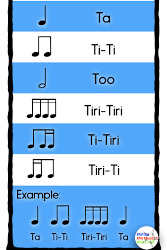

We can use the strategies in the video attached to see how children learn about rhythm in a class.
https://youtu.be/g7Wjl9x4N3U
https://youtu.be/G28sE4IlMh8
References
Page, T ( 2021, August 23) (Wk4) How can I teach my students about Rhythm moodlebook https://moodle.avondale.edu.au/mod/book/view.php?id=1234304
Images:
https://www.google.com/url?sa=i&url=https%3A%2F%2Fwww.musical-u.com%2Flearn%2Ftopic%2Fear-training%2Frhythm%2F&psig=AOvVaw2tzSMUXppZllTtfdzM3W4X&ust=1633148884576000&source=images&cd=vfe&ved=2ahUKEwi_jajqr6jzAhULAHIKHWDNA9cQr4kDegUIARDOAQ
https://www.google.com/url?sa=i&url=https%3A%2F%2Ftwitter.com%2Frhythmtrader&psig=AOvVaw2tzSMUXppZllTtfdzM3W4X&ust=1633148884576000&source=images&cd=vfe&ved=2ahUKEwi_jajqr6jzAhULAHIKHWDNA9cQr4kDegUIARDhAQ
https://www.google.com/url?sa=i&url=https%3A%2F%2Fmakemomentsmatter.org%2Fclassroom-ideas%2Frhythm-syllable-systems-what-to-use-and-why%2F&psig=AOvVaw1g7eUNe4c-Tfn-uDACyxZv&ust=1633148962049000&source=images&cd=vfe&ved=2ahUKEwir1KCPsKjzAhUmoksFHX9mCGkQr4kDegUIARC0AQ
https://www.google.com/url?sa=i&url=https%3A%2F%2Fdynamicmusicroom.com%2Fkodaly-counting-system%2F&psig=AOvVaw1g7eUNe4c-Tfn-uDACyxZv&ust=1633148962049000&source=images&cd=vfe&ved=2ahUKEwir1KCPsKjzAhUmoksFHX9mCGkQr4kDegUIARC-AQ
0 notes
Text
Week 3: What is the place and value of music in the Curriculum?

“I would teach children music, physics, and philosophy, but more importantly, music, for in the patterns of music and all the arts, are the keys to learning.” – Plato
Learning music can help students develop self-confidence, self-discipline, and teamwork. It builds confidence, self-expression and fosters creativity. An education inclusive of music maximises student opportunity. Music helps students progress in other important learning areas such as Maths and English, which involves learning to recognise and use patterns and sequences when composing, performing, and listening. Music stimulates incomparable development of a child’s brain and leads to improved concentration and memory abilities.
Music help students to acquire knowledge, skills, and understanding in performing music of different genres and other cultures. Children develop their knowledge, skills, and knowledge of their music and others. It also assists students in participating in and contributing to cultural life, becoming informed consumers of the arts and culture, empathizing with others, and considering their career paths.
According to the Australian Curriculum, in music, students learn to use the concepts and music materials to compose, arrange, perform, conduct, improvise and respond to their own and others’ work. They learn to understand the elements of music, duration (rhythm and tempo), dynamics, form, pitch (melody and harmony), and timbre (sound texture and quality). They apply this knowledge to music materials. They imagine and respond to their own and others’ music by developing specialised listening skills as composers, performers, and audience members. They learn forms of notation to record and communicate music and musical ideas. Students understand and engage with the multiple and culturally diverse music practices, learning about Australian and international music — locally, nationally, and globally. Students research traditions and contexts of music and music practices and develop the skills and techniques to reflect and respond to their own and others’ music practices. Learning in music is most effective when composing, performing, and listening is interconnected. Music learning is continuous as students develop and revisit skills, techniques, knowledge, and understanding with increasing depth and complexity. They develop an understanding of music as an aural art form and explore connections between music and other Arts subjects.
Years F-2
Students learn to participate in the different roles of composer, performer, and audience member. They explore and experiment with voice, instruments, and sound to create their music. They sing, play instruments, and found sound sources. They develop a repertoire of various chants, songs, rhythms, rhymes, and melodies. They invent and explore ways of researching and recording music through symbols. Students begin to use music terminology. They learn to listen and respond/comment to a range of musical works which belong to them or others and develop their aural skills.
Years3-4
Students use their developing aural skills and musical terminology in composing, performing, and responding to their own and others’ performances. They build on their knowledge as they use and select elements of music to structure simple musical compositions, which they record using invented and conventional notations. They sing, play instruments, move on the music, demonstrating an understanding of musical concepts. They use a range of technologies to record and communicate their musical ideas and access those of others. Through performing, listening, and composing, students identify musical elements in performances and share opinions about how they create meaning and musical effect in their own and others’ music.
Year5-6
Students develop an understanding of music concepts and elements to arrange, compose, improvise and perform music. They use various technologies to plan, organise and record their musical ideas and access those of others. Students’ musical practices are underpinned by developing music notation, aural skills, and music terminology. Their music-making as arrangers, composers, and improvisers demonstrates an increased awareness of various musical styles and genres. They perform an increasingly diverse musical repertoire of songs and instrumental compositions. In responding, students identify key features in music that they perform and listen to and make some informed judgments about musical preferences.
References:
Page, T (August 16,2021) Week 3: What is the place and value of music in the Curriculum? moodlebook https://moodle.avondale.edu.au/mod/book/view.php?id=1234256
Image:
https://www.alamy.com/stock-photo-musical-instruments-sketch-icon-102260628.html?pv=1&stamp=2&imageid=9DACC581-1238-489E-8123-0ED8A89CD4EC&p=302739&n=0&orientation=0&pn=1&searchtype=0&IsFromSearch=1&srch=foo%3dbar%26st%3d0%26pn%3d1%26ps%3d100%26sortby%3d2%26resultview%3dsortbyPopular%26npgs%3d0%26qt%3dmusical%2520instruments%2520sketch%26qt_raw%3dmusical%2520instruments%2520sketch%26lic%3d3%26mr%3d0%26pr%3d0%26ot%3d0%26creative%3d%26ag%3d0%26hc%3d0%26pc%3d%26blackwhite%3d%26cutout%3d%26tbar%3d1%26et%3d0x000000000000000000000%26vp%3d0%26loc%3d0%26imgt%3d0%26dtfr%3d%26dtto%3d%26size%3d0xFF%26archive%3d1%26groupid%3d%26pseudoid%3d%26a%3d%26cdid%3d%26cdsrt%3d%26name%3d%26qn%3d%26apalib%3d%26apalic%3d%26lightbox%3d%26gname%3d%26gtype%3d%26xstx%3d0%26simid%3d%26saveQry%3d%26editorial%3d1%26nu%3d%26t%3d%26edoptin%3d%26customgeoip%3d%26cap%3d1%26cbstore%3d1%26vd%3d0%26lb%3d%26fi%3d2%26edrf%3d%26ispremium%3d1%26flip%3d0%26pl%3d
0 notes
Text


Week 1& 2 : What are the Foundations of Primary Music?
My name is Nida Parveen, and I am a student studying Curriculum studies- Teaching Creative Arts ll & EC Arts. Through this blog post, I will explore, learn, and bring forth the importance of Music in the Creative Arts curriculum in the Primary school setting. I have never played any instrument, and I never composed. But the other day, I tried to play the guitar with my children in the preschool room last week for the first time. Even though the Music was not good but the sound of the guitar gave me a feeling of pride and joy. I was able to entertain my children and kept them hooked for a long time. As the children were happy, they joined me and sang the rhymes with me. It was sheer happiness.
What is Music?
Music is everywhere around us. It is in the chirping of the birds, in our walks, clock ticking, in the wind as it makes the leaves rustle, the moving car, moving bike, etc. It is everywhere, but sometimes we notice and sometimes we don’t. It has a Pitch, Rhythm, and Dynamics, which are called the elements of Music.
Pitch- It is a position of a single sound in the complete range of sound. Sounds are higher or lower in pitch according to the frequency of vibration of the sound waves producing them.
Rhythm- It is a strong, regular repeated pattern of sound.
Dynamics- It shows how quietly or loudly a piece of music should be played. It is displayed in the form of abbreviations for specific musical notations in the music notes. The study shows that Music plays an essential role in relaxing the mind, concentration, and motivation. So, it helps the children to learn better too.
What are the foundations of Music in a Primary school setting?
Learning in Music - Learning in Music involves exploring the elements of Music and how they work together, various forms of musical notation, and technical skills in singing and playing instruments. It also involves learning how to teach, program, and assess these areas.
Making in Music- Making in Music involves students exploring, improvising, composing, notating, practicing, refining, and performing.
Responding in Music - Responding in Music is about students appreciating their own and others’ musical works by listening, describing, reflecting on, analysing, appreciating, and evaluating.
Australian Curriculum, Assessment and Reporting Authority (ACARA) and NSW Curriculum Content Description for Music
According to the Australian Curriculum Assessment and Reporting Authority (ACARA), the content description and Achievement standards for Music based on the Year Levels are as follows:
Content Description: Foundation-Year 2
-Develop aural skills by exploring and imitating sounds, pitch, and rhythm patterns using voice, movement, and body percussion.
-Sing and play instruments to improvise, practice a repertoire of chants, songs, and rhymes, including songs used by cultural groups in the community
-Create compositions and perform Music to communicate ideas to an audience
-Respond to Music and consider where and why people make Music, starting with Australian Music, including Music of Aboriginal and Torres Strait Islander Peoples
Achievement Standards: Foundation- Yr 2
-Students improvise, compose, arrange and perform music. They demonstrate aural skills by staying in tune and keeping in time when they sing and play.
Content Description: Year 3-4
-Develop aural skills by exploring, imitating, and recognising elements of Music, including dynamics, pitch, and rhythm patterns
-Practise singing, playing instruments, and improvising music, using elements of music including rhythm, pitch, dynamics, and form in a range of pieces, including in Music from the local community
-Create, perform and record compositions by selecting and organising sounds, silence, tempo, and volume
-Identify intended purposes and meanings as they listen to Music using the elements of Music to make comparisons, starting with Australian Music, including Music of Aboriginal and Torres Strait Islander Peoples
Achievement Standards: Year 3-4
-Students collaborate to improvise, compose and arrange sound, silence, tempo, and volume in Music that communicates ideas. They demonstrate aural skills by singing and playing instruments with accurate pitch, rhythm, and expression.
Content Description: Year 5-6
-Explore dynamics and expression, using aural skills to identify and perform rhythm and pitch patterns
-Develop technical and expressive skills in singing and playing instruments with an understanding of rhythm, pitch, and form in a range of pieces, including in Music from the community
-Rehearse and perform Music, including Music they have composed by improvising, sourcing, and arranging ideas and making decisions to engage an audience
-Explain how the elements of Music communicate meaning by comparing Music from different social, cultural, and historical contexts, including Aboriginal and Torres Strait Islander Music.
Achievement Standards: Year5-6
-Students use rhythm, pitch, and form symbols and terminology to compose and perform music. They sing and play music in different styles, demonstrating aural, technical, and expressive skills by singing and playing instruments with accurate pitch, rhythm, and expression in performances for audiences.
I am excited and looking forward to learning and teaching music to the children in an absolute sense. I believe integrating Music in multiple KLAs makes the teaching and learning exciting and leaves a significant impact on the little minds. I would love to integrate it into different learning areas.
References:
Page, T ( 2021, August 9) Week 1& 2: What are the foundation of teaching creative arts: Music & dance. Moodle book https://moodle.avondale.edu.au/mod/book/view.php?id=1233992
Images:
https://www.google.com/url?sa=i&url=https%3A%2F%2Finstitute.careerguide.com%2Fknow-what-your-music-taste-says-about-your-personality%2F&psig=AOvVaw0pa7GCQwB2nYbTPup4PG9K&ust=1633149369066000&source=images&cd=vfe&ved=2ahUKEwiehavRsajzAhUtnEsFHfShCggQr4kDegUIARCPAQ
https://www.google.com/url?sa=i&url=https%3A%2F%2Fliveforlivemusic.com%2Ffeatures%2Fhow-music-can-be-used-to-influence-different-mood-goals%2F&psig=AOvVaw1Ds8KwARwIt1mS1pnJnKFJ&ust=1633149407566000&source=images&cd=vfe&ved=2ahUKEwic99jjsajzAhVbXysKHcJyCtcQr4kDegUIARC9AQ
0 notes
Text
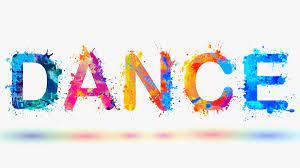

Week 1- What are the Foundations of Dance?
My name is Nida Parveen, and I am a student studying Curriculum studies- Teaching Creative Arts ll & EC Arts. Through this blog post, I will explore, learn, and bring forth the importance of Dance in the Creative Arts curriculum in the Primary school setting.
I have danced in my school life on various occasions but was never professionally trained. I have danced to Indian classical music and multiple dances that I didn’t even know had names. They were some of the joint creations with my friends or the copy of the dance videos we watched on TV. I am excited to learn and attain in-depth knowledge of Dance and music then teach it to my students to achieve my goal.
First, let’s get familiar with what Dance is all about and the foundations of Dance in the curriculum in the Primary school setting.
What is Dance? How is Dance used as a core part of the Australian Curriculum and NSW Curriculum under Creative Arts?
Dance involves the fundamental movement skills of the body. The movement begins from birth to communicate the needs, then to interpret ideas, expressions, and later it becomes the social language to communicate. In Dance, we use the body as a tool to communicate and express meaning through purposeful movement. The practice of Dance involves choreography, performance, appreciation, and response to dance and dance making.
Australian Curriculum, Assessment and Reporting Authority (ACARA) and NSW curriculum considers Dance
- a vital component of Creative Arts.
-provides opportunities for stimulating and rewarding students.
-promotes the use of the body in a safe way to explore, create, express, and perform provides the ideal medium to achieve the outcomes and content descriptions in the curriculum.
What are the Foundations of Dance in Primary Creative Arts?
The foundation of Dance is based on the three components:
Learning in Dance -It consists of ideas, content, learning, elements, skills, and processes that can help you in developing your understanding/teaching confidence in creative arts. Dance and to follow that the body is an instrument of expression to communicate and express meaning. It includes teaching activities, strategies, and warmups. Learning in Dance involves students exploring elements, skills, and processes through the integrated practices of choreography, performance, and appreciation.
Making in Dance- Making in Dance involves students improvising, choreographing, comparing and contrasting, refining, interpreting, practicing, rehearsing, and performing.
Responding in Dance- Responding in Dance is about students appreciating their own and others’ Dance works by viewing, describing, reflecting on, analysing, appreciating, and evaluating.
According to the Australian Curriculum Assessment and Reporting Authority (ACARA), the content description and Achievement standards for Dance based on the Year Levels are as follows:
Content Description: Foundation-Year 2
-Explore, improvise, and organise ideas to make dance sequences using the elements of Dance.
-Use fundamental movement skills to develop technical skills when practising dance sequences.
-Present Dance that communicates ideas to an audience, including Dance used by cultural groups in the community.
-Respond to dance and consider where and why people dance, starting with dances from Australia, including dances of Aboriginal and Torres Strait Islander Peoples.
Achievement Standards: Foundation- Yr 2
Students use the elements of Dance to make and perform dance sequences that demonstrate fundamental movement skills to represent ideas. Students demonstrate safe practice.
Content Description: Year 3-4
-Improvise and structure movement ideas for dance sequences using the elements of dance and choreographic devices.
-Practise technical skills safely in fundamental movements.
-Perform dances using expressive skills to communicate ideas, including telling cultural or community stories.
-Identify how the elements of dance and production express ideas in Dance they make, perform and experience as an audience, including exploration of Aboriginal and Torres Strait Islander dance.
Achievement standards: Year 3-4
Students structure movements into dance sequences and use the elements of dance and choreographic devices to represent a story or mood. They collaborate to make dances and perform with control, accuracy, projection and focus.
Content Description: Year 5-6
-Explore movement and choreographic devices using the elements of Dance to choreograph dances that communicate meaning.
-Develop technical and expressive skills in fundamental movements, including body control, accuracy, alignment, strength, balance, and coordination.
-Perform Dance using expressive skills to communicate a choreographer’s ideas, including performing dances of cultural groups in the community
-Explain how the elements of dance and production elements communicate meaning by comparing dances from different social, cultural, and historical contexts, including Aboriginal and Torres Strait Islander Dance
Achievement standards: Year5-6
Students structure movements in dance sequences and use the elements of dance and choreographic devices to make dances that communicate meaning. They work collaboratively to perform dances for audiences, demonstrating technical and expressive skills.
The above curriculum will be used in planning and assessing the Dance of the students at various levels.
References;
Page, T ( 2021, August 9) Week 1& 2: What are the foundation of teaching creative arts: Music & dance. Moodle book https://moodle.avondale.edu.au/mod/book/view.php?id=1233992
https://www.google.com/url?sa=i&url=https%3A%2F%2Feducation.ket.org%2Fresources%2Fdance-glossary%2F&psig=AOvVaw351oWM6YLDU9seZ-b8bLcH&ust=1633150309317000&source=images&cd=vfe&ved=2ahUKEwjOs9eRtajzAhUWxHMBHboJBikQr4kDegUIARDiAQ
https://www.google.com/url?sa=i&url=https%3A%2F%2Fwww.redbull.com%2Fint-en%2Fmusic%2Fa-history-of-afropop-dance-crazes&psig=AOvVaw351oWM6YLDU9seZ-b8bLcH&ust=1633150309317000&source=images&cd=vfe&ved=2ahUKEwjOs9eRtajzAhUWxHMBHboJBikQr4kDegUIARCJAg
0 notes